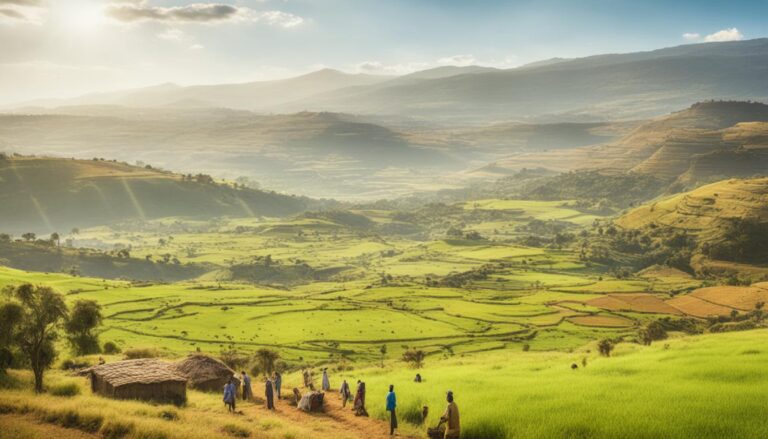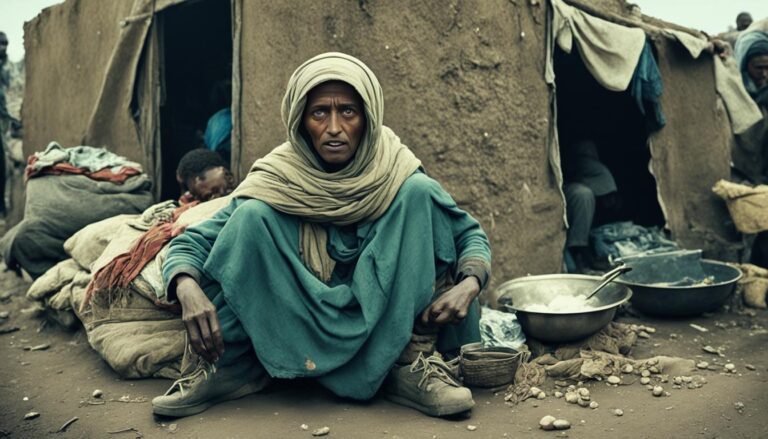Are Ethiopia and Eritrea the Same?
Did you know that Ethiopia and Eritrea, two neighboring countries in the Horn of Africa, share a complex history and a border that stretches over 1,000 kilometers? Despite their geographical proximity, these two nations have experienced wars, border disputes, and distinct political systems that set them apart. Let’s delve into the intriguing question: Are Ethiopia and Eritrea the same?
Key Takeaways:
- Ethiopia and Eritrea have a complex history of conflict and border disputes.
- Although they share some cultural similarities, they have distinct languages and cultural differences.
- Ethiopia has a federal parliamentary republic, while Eritrea is a one-party presidential republic.
- The Eritrean-Ethiopian War from 1998 to 2000 was fought over border territories.
- Recent developments have seen a resumption of diplomatic relations between the two countries, but challenges remain.
Historical Background of Ethiopia and Eritrea
Ethiopia and Eritrea have a rich and intertwined history, characterized by both cooperation and conflict. To understand their present relationship, it is crucial to delve into their historical background.
Eritrea, a former Italian colony, was federated with Ethiopia in the 1950s under the auspices of the United Nations. However, this union was not without tensions and grievances, leading to a prolonged struggle for independence.
From 1961 to 1991, Eritrea fought a war of independence against Ethiopian rule. This armed conflict, marked by resilience and determination, eventually culminated in Eritrea’s independence in 1993.
The aftermath of independence did not bring about lasting peace between the two nations. Instead, it led to a deterioration of relations, with deep-rooted animosity and unresolved border disputes coming to the forefront.
The late 1990s witnessed a significant escalation in tensions, resulting in the Eritrean-Ethiopian War from 1998 to 2000. This devastating conflict claimed thousands of lives and caused immense suffering on both sides.
Amidst the chaos and destruction, it became evident that a new approach was needed to forge a path towards peace and stability.
Key Dates in the History of Ethiopia and Eritrea:
| Era | Event |
|---|---|
| 1889 | Italy establishes a colony in Eritrea |
| 1950s | Federation of Eritrea with Ethiopia |
| 1961-1991 | Eritrean War of Independence |
| 1993 | Eritrea gains independence |
| 1998-2000 | Eritrean-Ethiopian War |
Cultural and Linguistic Differences

While Ethiopia and Eritrea share some cultural similarities, they also have distinct cultural and linguistic differences that contribute to their unique identities. Ethiopia, known for its rich diversity, is home to over 80 recognized ethnic groups, each with its own traditions, customs, and languages spoken.
Eritrea, on the other hand, recognizes nine ethnic groups and multiple languages, including Tigrinya, Arabic, and Tigre. These linguistic variations reflect the cultural diversity within Eritrea, further enriching its heritage.
The linguistic differences between Ethiopia and Eritrea play a significant role in shaping their respective cultural landscapes. The diverse languages spoken in Ethiopia foster a vibrant mix of traditions, art forms, and values, creating a colorful tapestry of cultures. In contrast, Eritrea’s language diversity contributes to a unique cultural identity rooted in its historical and geopolitical contexts.
Despite their differences, Ethiopia and Eritrea also share commonalities that stem from their geographical proximity, historical interactions, and shared regional influence. Both nations have witnessed colonial rule and fought for independence, leading to a shared history of struggle and resilience.
To grasp a better understanding of the cultural and linguistic aspects of Ethiopia and Eritrea, let’s take a closer look at a comparison of the recognized ethnic groups and languages:
| Country | Recognized Ethnic Groups | Languages |
|---|---|---|
| Ethiopia | Over 80 | Multiple languages, including Amharic, Oromo, Tigrinya, Somali, and more |
| Eritrea | 9 | Tigrinya, Arabic, Tigre, and others |
This table provides a glimpse into the cultural and linguistic diversity within Ethiopia and Eritrea, highlighting the range of ethnic groups and languages that contribute to the tapestry of their respective societies.
To explore further insights into the unique aspects of Ethiopian and Eritrean culture and language, let’s move on to the next section.
Political Systems and Governments

Ethiopia and Eritrea have different political systems and governments. Let’s take a closer look at each country’s political structure.
Ethiopia:
Ethiopia is a federal parliamentary republic with a multi-party system. The country follows a constitution that sets up a separation of powers between the executive, legislative, and judicial branches. The President serves as the head of state, while the Prime Minister holds the position of head of government.
Ethiopia’s Parliament consists of two chambers – the House of Peoples’ Representatives and the House of Federation. Members of the House of Peoples’ Representatives are elected by the people, while members of the House of Federation are selected by state legislatures.
Ethiopia holds regular elections, allowing citizens to participate in the democratic process and choose their representatives. The country has made efforts to promote political inclusivity and encourage the involvement of various political parties.
Eritrea:
Eritrea, on the other hand, is a one-party presidential republic. The ruling party in Eritrea is the People’s Front for Democracy and Justice (PFDJ), and power is concentrated in the hands of President Isaias Afwerki.
Eritrea does not have a multi-party system or regular elections. The PFDJ has been the only legally permitted political party in the country since 1993. The President has significant control over the government and decision-making processes.
It is important to note that Eritrea has been criticized for its human rights record and lack of political freedoms.
| Country | Political System | Main Decision-Maker |
|---|---|---|
| Ethiopia | Federal Parliamentary Republic | Prime Minister |
| Eritrea | One-Party Presidential Republic | President Isaias Afwerki |
Note: Please keep in mind that the political situation in Eritrea may change over time.
Border Disputes and Conflict

One of the main sources of contention between Ethiopia and Eritrea is their border disputes. The Eritrean-Ethiopian War in the late 1990s was primarily fought over border territories. The conflict resulted in significant casualties and displacement of people on both sides. Although the war officially ended in 2000, the border disputes have not been fully resolved, leading to continued tensions.
| Impact of the Border Disputes and Conflict | |
|---|---|
| 1. Casualties | The war between Ethiopia and Eritrea resulted in a high number of casualties on both sides, leading to immense human suffering. |
| 2. Displacement | The conflict forced many people to flee their homes, resulting in large-scale displacement and adding to the humanitarian crisis in the region. |
| 3. Continued Tensions | Although the war formally ended, the unresolved border disputes have perpetuated tensions between Ethiopia and Eritrea, hindering the potential for peaceful coexistence and cooperation. |
The consequences of the border disputes and conflict have had far-reaching implications for both countries. It has stifled development, hindered economic growth, and affected the well-being of the populations living in the border regions.
Recent Developments and Relations
In recent years, there have been significant developments in the relations between Ethiopia and Eritrea. In 2018, Ethiopian Prime Minister Abiy Ahmed and Eritrean President Isaias Afwerki announced the resumption of diplomatic relations and opened their borders. This marked a historic turning point in the relationship between the two countries that had been strained for decades.
The reestablishment of diplomatic ties led to the establishment of embassies in each other’s capitals and the resumption of direct flights between the two countries. This has allowed for increased people-to-people exchanges and trade opportunities, fostering cultural understanding and economic cooperation.
“We are excited to reopen our borders and resume diplomatic relations with our neighbors in Eritrea. This is a significant step towards peace and stability in the region.”
– Prime Minister Abiy Ahmed
Despite these positive developments, there are still challenges to fully normalizing relations between Ethiopia and Eritrea. One of the key issues that remains unresolved is the border disputes between the two countries. The demarcation of the border has yet to be finalized, and this has been a source of ongoing tensions.
Efforts to resolve the border disputes and strengthen relations are ongoing, with both Ethiopia and Eritrea expressing their commitment to peaceful coexistence and regional cooperation. The international community continues to support these efforts and encourage dialogue between the two countries.
The Impact of Improved Relations
The improved relations between Ethiopia and Eritrea have had a positive impact on the region. It has not only allowed for increased trade and economic opportunities but has also created a more stable and peaceful environment.
With the reopening of borders, families separated for years have been reunited, and individuals have been able to travel freely between the two countries. This has facilitated cultural exchanges and promoted people-to-people connections.
Furthermore, the improved relations have opened up new possibilities for regional cooperation and integration. Ethiopia and Eritrea have been working together with other countries in the Horn of Africa to address common challenges and promote sustainable development. This includes initiatives in areas such as infrastructure development, energy cooperation, and joint efforts to combat terrorism and extremism.
| Ethiopia | Eritrea | |
|---|---|---|
| Government | Federal parliamentary republic | One-party presidential republic |
| Official Languages | Amharic | Tigrinya, Arabic, English |
| Population | 117 million | 3.5 million |
| Religion | Christianity, Islam | Islam, Christianity |
The improved relations between Ethiopia and Eritrea are a testament to the power of diplomacy and dialogue in resolving conflicts. While challenges remain, the progress made so far is a cause for optimism and provides hope for a more prosperous and peaceful future for both countries and the entire region.
Economic and Trade Relations
While the border disputes and conflict have limited economic and trade relations between Ethiopia and Eritrea, efforts have been made to improve cooperation in certain areas.
In terms of transportation, both countries have taken steps to enhance connectivity. Ethiopia has invested in improving its road infrastructure to facilitate trade with Eritrea. Eritrea, on the other hand, has focused on upgrading its ports, making them more efficient for import and export activities.
Quote:
“Enhancing economic cooperation between Ethiopia and Eritrea is crucial for the development of both nations. By leveraging their geographical proximity and complementary resources, they have the potential to foster mutually beneficial trade relations.” – Trade Expert
In addition to transportation, trade ties have also been explored. The two countries have initiated discussions to identify potential trade opportunities and address trade barriers. However, due to the lingering border disputes and political tensions, the full potential of economic relations has yet to be realized.
A table depicting the current trade statistics between Ethiopia and Eritrea is provided below:
| Year | Ethiopian Exports to Eritrea (in USD) | Ethiopian Imports from Eritrea (in USD) |
|---|---|---|
| 2018 | 1,500,000 | 800,000 |
| 2019 | 1,200,000 | 700,000 |
| 2020 | 900,000 | 500,000 |
Although the figures show a decrease in trade between the two countries, it is important to consider the broader context of the border disputes and ongoing tensions.
Efforts to enhance economic and trade relations between Ethiopia and Eritrea require continued dialogue, diplomatic engagement, and resolution of the existing conflicts. It is crucial to prioritize stability and cooperation to unlock the economic potential of both nations.
Humanitarian and Refugee Issues
The conflicts between Ethiopia and Eritrea have had far-reaching consequences, resulting in significant humanitarian crises and mass displacement of people. Both countries have experienced an influx of refugees and internally displaced populations, contributing to the urgent need for humanitarian assistance and support.
The Ethiopia-Eritrea conflict has led to a large number of people being forced to leave their homes and seek safety elsewhere. Many have been uprooted from their communities, separated from their families, and exposed to harsh living conditions. The widespread displacement has created immense challenges in providing adequate food, water, healthcare, and shelter to those affected.
In addition to the internal displacement, the conflict has also generated a significant number of refugees fleeing to neighboring countries. These refugees often face difficulties in accessing basic services and protection, exacerbating their vulnerability and increasing the strain on host communities.
Resolving the conflicts between Ethiopia and Eritrea is essential to address the humanitarian and refugee issues in the region. It requires sustainable peacebuilding efforts, diplomatic negotiations, and international cooperation. Providing humanitarian aid, safe havens, and support for the affected populations is crucial to alleviate their suffering and ensure their well-being.
“The conflicts between Ethiopia and Eritrea have caused immense human suffering and displacement. It is our collective responsibility to come together and find lasting solutions for the affected populations.”
Efforts must be made to create safe conditions for the displaced populations to return to their homes, rebuild their lives, and regain their livelihoods. This includes addressing the root causes of the conflict, resolving border disputes, and fostering reconciliation and trust between the two countries.
International organizations, governments, and humanitarian agencies play a vital role in providing assistance and protection to those affected by the Ethiopia-Eritrea conflict. Through collaborative efforts, we can support the affected populations, promote stability in the region, and contribute to long-term peace and development.
| Humanitarian and Refugee Issues | Key Points |
|---|---|
| Mass displacement of people | Resulting from the conflicts |
| Influx of refugees | Fleeing from Ethiopia and Eritrea |
| Challenges in providing aid | Access to food, water, healthcare, and shelter |
| International cooperation | Essential for resolution and support |
| Efforts for safe return | Addressing root causes and fostering trust |
The image above visually represents the impact of the Ethiopia-Eritrea conflict on humanitarian and refugee issues. It reminds us of the pressing need to address the challenges faced by displaced populations and the importance of finding sustainable solutions for lasting peace and stability in the region.
International Efforts and Mediation
The resolution of the conflicts between Ethiopia and Eritrea requires the involvement of the international community. Numerous organizations and countries have contributed to mediating and facilitating peace talks, as well as supporting reconciliation processes.
We have seen the United Nations play a crucial role in promoting dialogue and negotiations between Ethiopia and Eritrea. The UN Secretary-General and various UN envoys have been actively engaged in diplomatic efforts to bring the two countries closer to a peaceful resolution.
“The international community must come together and support the Ethiopian and Eritrean governments in their pursuit of lasting peace. Our combined efforts can make a significant difference in achieving stability and prosperity in the region.” – United Nations Representative
In addition to the United Nations, regional organizations such as the African Union have also played a vital part in the mediation process. The African Union Commission Chairperson and other high-level officials have been involved in facilitating negotiations and fostering dialogue between the two countries.
Furthermore, neighboring countries, such as Sudan and Djibouti, have worked towards mediating the conflict and promoting peaceful relations between Ethiopia and Eritrea.
The international community recognizes the importance of sustained engagement and support to achieve a lasting resolution to the Ethiopia-Eritrea conflict. Continued cooperation and mediation efforts are crucial in ensuring long-term peace and stability in the region.
International Organizations and Countries Involved in Mediation
| Organization/Country | Role |
|---|---|
| United Nations | Facilitated peace talks and provided diplomatic support |
| African Union | Engaged in mediation efforts and fostered dialogue |
| Neighboring countries (Sudan, Djibouti) | Worked towards mediation and peaceful relations |
Efforts to mediate and resolve the Ethiopia-Eritrea conflict have been crucial in ensuring the well-being of the affected populations and fostering regional stability. By working together, we can create a better future for both countries and the entire Horn of Africa region.
Conclusion
After exploring the complex history and relations between Ethiopia and Eritrea, it is clear that while they may share some cultural similarities, they are distinct countries with unique political systems, governments, and experiences. The conflicts and border disputes that have plagued their relationship have had far-reaching consequences, affecting not only their bilateral ties but also the well-being of their populations.
In order to achieve stability and promote regional development, it is imperative for Ethiopia and Eritrea to prioritize the resolution of these conflicts and the establishment of peaceful and mutually beneficial relations. By working towards sustainable solutions and fostering cooperation, both countries can create an environment conducive to progress and prosperity.
International efforts and mediation have played a crucial role in facilitating dialogue and reconciliation between Ethiopia and Eritrea. However, sustained engagement and continued support from the international community will be essential in ensuring long-term peace and stability in the region.
Ultimately, while Ethiopia and Eritrea may not be the same, their shared history and experiences serve as a reminder of the interconnectedness of nations and the importance of fostering understanding and cooperation for the greater good.






